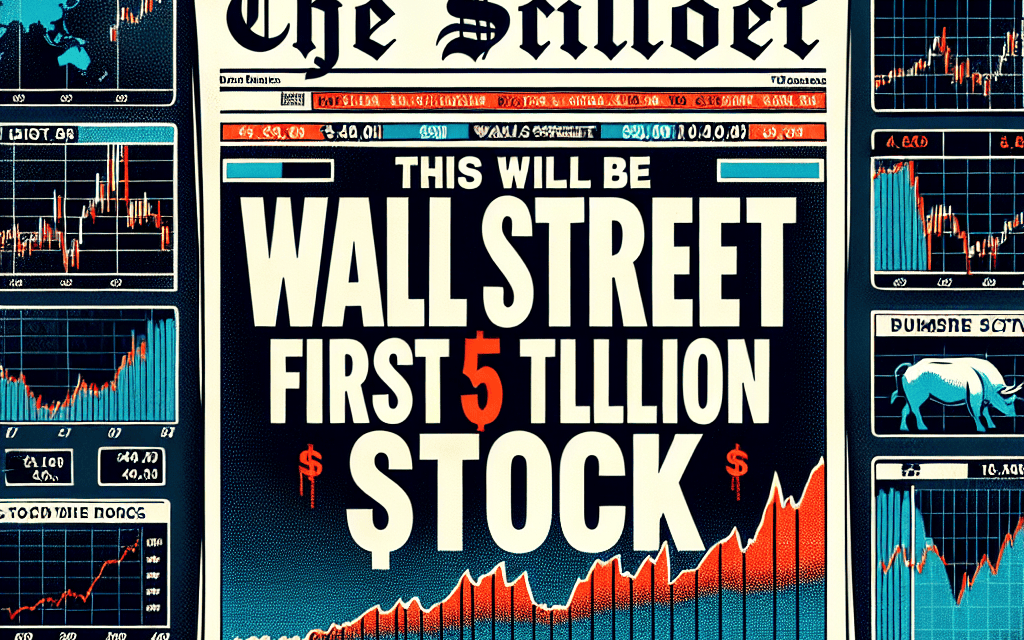“Breaking Barriers: The First $5 Trillion Titan of Wall Street”
Introduction
In the ever-evolving landscape of global finance, the race to identify the next monumental milestone in market capitalization is a constant pursuit for investors and analysts alike. As Wall Street continues to be the epicenter of financial innovation and growth, the anticipation surrounding which company will first achieve the unprecedented valuation of $5 trillion is intensifying. This prediction not only reflects the dynamic shifts in economic power and technological advancement but also underscores the strategic maneuvers and visionary leadership required to reach such a pinnacle. As we delve into the factors that could propel a company to this historic achievement, we explore the potential candidates poised to redefine the boundaries of corporate success and set a new benchmark in the annals of financial history.
The Rise Of The $5 Trillion Stock: Key Indicators And Predictions
As the global financial landscape continues to evolve, the prospect of a $5 trillion stock on Wall Street is becoming increasingly plausible. This potential milestone is not merely a reflection of market exuberance but rather a testament to the transformative forces at play within the economy. To understand the trajectory towards this unprecedented valuation, it is essential to examine the key indicators and predictions that suggest which company might first achieve this remarkable feat.
In recent years, the stock market has witnessed a significant shift, driven by technological advancements and the digital transformation of industries. Companies that have successfully harnessed these changes have seen their valuations soar, with tech giants like Apple, Microsoft, and Amazon leading the charge. These companies have not only revolutionized their respective sectors but have also expanded their influence across various domains, creating ecosystems that are integral to modern life. Consequently, their market capitalizations have surged, bringing them closer to the $5 trillion mark.
One of the primary indicators of a company’s potential to reach such a valuation is its ability to innovate and adapt. Companies that consistently invest in research and development, and that are willing to pivot in response to market demands, are better positioned to sustain long-term growth. For instance, Apple’s continuous innovation in consumer electronics and its expansion into services like streaming and financial products have bolstered its market position. Similarly, Microsoft’s strategic focus on cloud computing and artificial intelligence has propelled its growth, making it a strong contender in the race to $5 trillion.
Moreover, the global reach and diversification of a company’s revenue streams play a crucial role in its valuation. Companies that operate on a global scale and have diversified their offerings are more resilient to economic fluctuations and geopolitical uncertainties. Amazon, with its vast e-commerce platform, cloud services, and ventures into entertainment and logistics, exemplifies this diversification. Such a broad portfolio not only mitigates risks but also opens up new avenues for revenue generation, thereby enhancing the company’s valuation prospects.
Another critical factor is the ability to leverage data and analytics to drive decision-making and optimize operations. In today’s data-driven world, companies that can effectively harness data to improve customer experiences, streamline processes, and identify new opportunities are at a distinct advantage. This capability not only enhances operational efficiency but also fosters innovation, enabling companies to stay ahead of the competition and maintain their growth trajectory.
Furthermore, the role of sustainability and corporate responsibility cannot be overlooked. As investors increasingly prioritize environmental, social, and governance (ESG) factors, companies that demonstrate a commitment to sustainable practices are likely to attract more investment. This shift in investor sentiment underscores the importance of integrating ESG considerations into business strategies, as it can significantly impact a company’s valuation.
In conclusion, the rise of the $5 trillion stock on Wall Street is not a question of if, but when. The convergence of technological innovation, global diversification, data-driven decision-making, and sustainable practices are key indicators that will drive this evolution. While several companies are in the running, those that can effectively navigate these dynamics and continue to deliver value to shareholders will be best positioned to achieve this historic milestone. As we look to the future, it is clear that the first $5 trillion stock will be a reflection of the profound changes shaping the global economy.
Wall Street’s Next Giant: Companies Poised To Hit The $5 Trillion Mark
As the global economy continues to evolve, the financial markets are witnessing unprecedented growth, with technology companies leading the charge. Among these giants, one company stands out as the most likely candidate to become Wall Street’s first $5 trillion stock: Apple Inc. This prediction is not merely speculative; it is grounded in a comprehensive analysis of the company’s current trajectory, market dynamics, and strategic initiatives.
To begin with, Apple’s robust financial performance provides a solid foundation for its potential ascent to the $5 trillion mark. The company has consistently demonstrated its ability to generate substantial revenue and profit, driven by its diverse product portfolio and innovative ecosystem. Apple’s flagship products, such as the iPhone, iPad, and Mac, continue to dominate their respective markets, while its services segment, including the App Store, Apple Music, and iCloud, has emerged as a significant growth driver. This diversification not only mitigates risks associated with reliance on a single product line but also positions Apple to capitalize on multiple revenue streams.
Moreover, Apple’s commitment to innovation and technological advancement is a critical factor in its potential to reach this unprecedented valuation. The company has a proven track record of introducing groundbreaking products that redefine consumer expectations and create new market opportunities. For instance, the introduction of the Apple Watch and AirPods has expanded Apple’s reach into the wearables market, while its foray into augmented reality and autonomous vehicles signals its intent to explore new frontiers. By continually pushing the boundaries of technology, Apple is well-positioned to maintain its competitive edge and drive future growth.
In addition to its innovative prowess, Apple’s strategic focus on sustainability and environmental responsibility enhances its appeal to a growing segment of socially conscious investors. The company has made significant strides in reducing its carbon footprint, transitioning to renewable energy, and promoting recycling initiatives. These efforts not only align with global sustainability goals but also resonate with consumers and investors who prioritize environmental stewardship. As the demand for sustainable investments continues to rise, Apple’s commitment to these principles could further bolster its market valuation.
Furthermore, Apple’s expansive global presence and strong brand loyalty provide a formidable advantage in capturing emerging market opportunities. The company’s ability to adapt its products and services to meet the diverse needs of international consumers has facilitated its penetration into key markets such as China and India. As these economies continue to grow, Apple’s established foothold positions it to benefit from increased consumer spending and technological adoption. This global reach, coupled with a loyal customer base, ensures a steady stream of revenue and reinforces Apple’s status as a market leader.
While challenges such as regulatory scrutiny and geopolitical tensions remain, Apple’s strategic initiatives and financial resilience equip it to navigate these complexities effectively. The company’s substantial cash reserves and prudent financial management provide a buffer against potential disruptions, allowing it to invest in research and development, strategic acquisitions, and shareholder returns.
In conclusion, Apple’s combination of financial strength, innovative capacity, sustainability initiatives, and global reach makes it a prime candidate to become Wall Street’s first $5 trillion stock. As the company continues to execute its strategic vision and adapt to an ever-changing market landscape, it is poised to achieve this remarkable milestone, setting a new benchmark for corporate success in the 21st century.
Market Trends: How The $5 Trillion Stock Will Reshape Wall Street
As the financial landscape continues to evolve, investors and analysts alike are constantly on the lookout for the next big opportunity that could reshape Wall Street. In recent years, the focus has shifted towards identifying the first company that could achieve a market capitalization of $5 trillion. This milestone, once considered unattainable, now seems within reach due to the rapid advancements in technology, globalization, and the increasing influence of digital platforms. The implications of such a development are profound, as it would not only redefine market dynamics but also set a new benchmark for corporate success.
To understand how a $5 trillion stock could emerge, it is essential to examine the current market trends and the factors driving growth in the corporate world. One of the most significant trends is the rise of technology companies, which have consistently outperformed traditional industries in terms of growth and innovation. Companies like Apple, Microsoft, and Amazon have already surpassed the $1 trillion mark, with some even reaching $2 trillion. These tech giants have leveraged their ability to innovate and adapt to changing consumer demands, positioning themselves as leaders in the digital age.
Moreover, the increasing integration of artificial intelligence, machine learning, and data analytics into business operations has provided companies with unprecedented opportunities to enhance efficiency and drive revenue growth. As these technologies continue to mature, they are likely to play a crucial role in propelling a company towards the $5 trillion milestone. Additionally, the global expansion of digital platforms has opened up new markets and revenue streams, further contributing to the potential for exponential growth.
Another critical factor to consider is the role of mergers and acquisitions in achieving such a monumental market capitalization. Strategic acquisitions can provide companies with access to new technologies, talent, and customer bases, accelerating their growth trajectory. For instance, the acquisition of a promising startup with a groundbreaking technology could catapult a company into a new realm of possibilities, bringing it closer to the $5 trillion mark. Furthermore, partnerships and collaborations with other industry leaders can also enhance a company’s competitive edge, enabling it to capture a larger share of the market.
In addition to these growth drivers, the evolving regulatory environment and investor sentiment will also play a significant role in shaping the path to a $5 trillion valuation. As governments around the world grapple with the challenges posed by rapidly advancing technologies, regulatory frameworks are likely to evolve, impacting how companies operate and grow. Companies that can navigate these changes effectively and maintain investor confidence will be better positioned to achieve this historic milestone.
The emergence of a $5 trillion stock would undoubtedly have far-reaching implications for Wall Street and the broader financial ecosystem. It would set a new standard for corporate valuation, prompting investors to reassess their strategies and priorities. Moreover, it could lead to increased scrutiny and regulatory oversight, as policymakers seek to ensure that such immense market power is wielded responsibly.
In conclusion, while predicting the first $5 trillion stock is inherently speculative, the convergence of technological innovation, strategic growth initiatives, and favorable market conditions suggests that this milestone is not only possible but likely in the foreseeable future. As companies continue to push the boundaries of what is achievable, the financial world must prepare for the profound impact that such a development will have on Wall Street and beyond.
Investment Strategies: Preparing For The First $5 Trillion Stock

As the financial landscape continues to evolve, investors are constantly on the lookout for the next big opportunity that could redefine market dynamics. One such prospect is the emergence of Wall Street’s first $5 trillion stock, a milestone that seems increasingly plausible given the rapid growth of certain tech giants and the expanding global economy. To prepare for this unprecedented event, investors must adopt strategic approaches that not only anticipate market trends but also mitigate potential risks.
The journey to a $5 trillion valuation is not merely a function of market speculation; it is deeply rooted in the fundamental performance and innovative capabilities of a company. Historically, companies that have reached significant market capitalizations have done so by consistently delivering value through groundbreaking products, strategic acquisitions, and robust financial health. For instance, the tech sector, with its relentless pace of innovation and global reach, has been a fertile ground for such growth. Companies like Apple, Microsoft, and Amazon have already crossed the $1 trillion mark, with some even surpassing $2 trillion, setting the stage for the next leap forward.
In light of this, investors should focus on identifying companies with strong competitive advantages, such as proprietary technology, brand loyalty, and scalable business models. These attributes not only drive revenue growth but also create barriers to entry for potential competitors, thereby sustaining long-term profitability. Moreover, companies that demonstrate a commitment to sustainability and social responsibility are likely to attract a broader investor base, further enhancing their market appeal.
Transitioning from identifying potential candidates to actual investment requires a nuanced understanding of market conditions and timing. Diversification remains a cornerstone of any sound investment strategy, as it helps spread risk across different asset classes and sectors. By maintaining a balanced portfolio, investors can capitalize on growth opportunities while cushioning against market volatility. Additionally, staying informed about macroeconomic trends, such as interest rate changes and geopolitical developments, can provide valuable insights into market movements and help refine investment decisions.
Furthermore, the role of technological advancements cannot be overstated in the quest for the first $5 trillion stock. The integration of artificial intelligence, machine learning, and data analytics into business operations has revolutionized industries, driving efficiency and innovation. Companies that leverage these technologies to enhance their product offerings and streamline processes are likely to experience accelerated growth, making them prime candidates for substantial market valuations.
As we look to the future, it is essential to recognize that the path to a $5 trillion valuation will not be without challenges. Regulatory scrutiny, market saturation, and economic downturns are potential obstacles that could impede progress. Therefore, investors must remain vigilant and adaptable, ready to adjust their strategies in response to changing circumstances.
In conclusion, the anticipation of Wall Street’s first $5 trillion stock presents both an exciting opportunity and a complex challenge for investors. By focusing on companies with strong fundamentals, embracing diversification, and staying attuned to technological and economic trends, investors can position themselves to benefit from this historic milestone. As the market continues to evolve, those who are prepared to navigate its intricacies will be best poised to reap the rewards of this unprecedented growth.
Tech Titans Or Financial Behemoths: Who Will Reach $5 Trillion First?
In the ever-evolving landscape of global finance, the race to become the first $5 trillion stock is a captivating narrative that has captured the attention of investors and analysts alike. As we delve into this intriguing competition, it is essential to consider the key players vying for this unprecedented milestone. The contenders are primarily drawn from two sectors: technology titans and financial behemoths. Each sector brings its unique strengths and challenges to the table, making the prediction of the eventual victor a complex yet fascinating endeavor.
To begin with, technology companies have consistently demonstrated their potential to achieve exponential growth. Giants such as Apple, Microsoft, and Amazon have already crossed the $1 trillion mark, with Apple even surpassing $2 trillion. These companies have leveraged their innovative prowess, global reach, and adaptability to maintain a competitive edge. For instance, Apple’s ecosystem of products and services continues to expand, while Microsoft’s cloud computing division, Azure, has become a cornerstone of its growth strategy. Similarly, Amazon’s dominance in e-commerce and cloud services positions it as a formidable contender. The tech sector’s ability to harness cutting-edge technologies such as artificial intelligence, machine learning, and the Internet of Things further bolsters its prospects.
However, the path to $5 trillion is not without obstacles. Regulatory scrutiny, market saturation, and geopolitical tensions pose significant challenges. Governments worldwide are increasingly scrutinizing the influence and practices of tech giants, which could lead to stricter regulations and potential antitrust actions. Moreover, as these companies expand globally, they must navigate diverse regulatory environments and cultural landscapes. Despite these hurdles, the tech sector’s resilience and capacity for innovation suggest that it remains a strong candidate in the race to $5 trillion.
On the other hand, financial behemoths such as JPMorgan Chase, Berkshire Hathaway, and Visa also present compelling cases for reaching this milestone. These institutions have long been pillars of stability and growth in the financial sector. Their extensive networks, diversified portfolios, and strategic investments provide a solid foundation for sustained expansion. For example, JPMorgan Chase’s robust investment banking and asset management divisions have consistently delivered strong financial performance. Meanwhile, Berkshire Hathaway’s diverse holdings across various industries offer a unique blend of stability and growth potential.
Nevertheless, the financial sector faces its own set of challenges. Economic fluctuations, regulatory changes, and technological disruptions can impact growth trajectories. The rise of fintech companies and digital currencies is reshaping the financial landscape, compelling traditional institutions to innovate and adapt. While these challenges are formidable, the financial sector’s ability to leverage its vast resources and expertise cannot be underestimated.
In conclusion, the race to become Wall Street’s first $5 trillion stock is a dynamic and multifaceted contest. Both technology titans and financial behemoths possess the attributes necessary to achieve this remarkable feat. While tech companies benefit from their innovative capabilities and global reach, financial institutions offer stability and diversification. Ultimately, the outcome will depend on how these entities navigate the challenges and opportunities that lie ahead. As investors and analysts continue to monitor this race, one thing is certain: the journey to $5 trillion will be a defining chapter in the annals of financial history.
Economic Impacts: The Ripple Effect Of A $5 Trillion Stock
The prospect of a $5 trillion stock on Wall Street is not merely a financial milestone; it represents a seismic shift in the economic landscape with far-reaching implications. As we consider the potential for a company to reach this unprecedented valuation, it is essential to explore the ripple effects such a development would have on the broader economy. The journey to a $5 trillion market capitalization would likely be driven by a combination of technological innovation, strategic acquisitions, and global market expansion. As a company grows to this size, its influence extends beyond its industry, affecting various sectors and stakeholders.
To begin with, the emergence of a $5 trillion stock would likely catalyze significant changes in investor behavior. Institutional investors, who manage vast sums of capital, would be drawn to the stability and growth potential of such a behemoth. This influx of investment could lead to increased liquidity in the stock market, potentially driving up valuations of other companies as well. Moreover, retail investors, often swayed by the movements of institutional players, might also flock to this stock, further amplifying its market impact. Consequently, the stock’s performance could become a barometer for the overall health of the financial markets, influencing investor sentiment and decision-making.
Furthermore, the economic implications extend to the labor market. A company of this magnitude would likely be a major employer, offering a wide array of job opportunities across different regions. Its growth could spur job creation not only within the company but also in its supply chain and related industries. As a result, regions where the company has a significant presence might experience economic revitalization, with increased demand for housing, services, and infrastructure. This, in turn, could lead to a rise in local tax revenues, enabling governments to invest in public services and community development.
In addition to these direct impacts, the rise of a $5 trillion stock would have profound effects on innovation and competition. As the company expands its reach, it would likely invest heavily in research and development to maintain its competitive edge. This could lead to breakthroughs in technology and business practices, setting new industry standards and driving progress across multiple sectors. However, the company’s dominance might also pose challenges for smaller competitors, who could struggle to match its resources and capabilities. This dynamic could lead to increased consolidation within industries, as companies seek to merge or form alliances to remain competitive.
Moreover, the global nature of a $5 trillion company means its influence would not be confined to domestic markets. Its operations and investments would span continents, impacting international trade and economic relations. The company’s decisions regarding supply chains, manufacturing locations, and market entry strategies could have significant implications for global economic patterns. Countries hosting its operations might benefit from increased foreign direct investment, while those excluded could face economic disadvantages.
In conclusion, the advent of Wall Street’s first $5 trillion stock would be a transformative event with wide-ranging economic impacts. From influencing investor behavior and labor markets to driving innovation and shaping global economic dynamics, the ripple effects would be felt across the financial landscape. As we anticipate this milestone, it is crucial to consider not only the opportunities it presents but also the challenges it poses, ensuring that the benefits of such growth are equitably distributed and sustainable in the long term.
Historical Milestones: Lessons From The Journey To $5 Trillion Valuations
The journey to a $5 trillion valuation is a monumental milestone that reflects not only the growth of a company but also the evolution of the global economy and financial markets. Historically, reaching such a valuation was once considered an unattainable feat, yet the rapid advancements in technology and globalization have shifted this perspective. To understand the significance of a $5 trillion valuation, it is essential to examine the historical milestones that have paved the way for such achievements and the lessons they impart.
In the late 20th century, the notion of a trillion-dollar company was itself a distant dream. However, as the digital age dawned, companies like Microsoft and Apple began to redefine the boundaries of market capitalization. The first major milestone was reached in 2018 when Apple became the first publicly traded U.S. company to achieve a $1 trillion valuation. This achievement was not merely a reflection of Apple’s innovative products but also a testament to the power of brand loyalty and strategic market positioning. Following closely, other tech giants such as Amazon and Microsoft soon joined the trillion-dollar club, underscoring the pivotal role of technology in driving economic growth.
As we transition into the 21st century, the pace of technological advancement has accelerated, with artificial intelligence, cloud computing, and digital transformation becoming integral components of business strategies. These innovations have not only expanded the potential for revenue generation but have also increased the scalability of businesses, allowing them to reach global markets with unprecedented speed. Consequently, the path to a $5 trillion valuation is becoming increasingly plausible, particularly for companies that can harness these technologies effectively.
Moreover, the globalization of financial markets has facilitated the flow of capital across borders, enabling companies to access a broader investor base. This has been instrumental in driving up valuations, as investors seek opportunities in high-growth sectors. The rise of institutional investors and sovereign wealth funds has further amplified this trend, providing substantial capital inflows to companies with promising growth prospects. As a result, the financial ecosystem has evolved to support larger valuations, setting the stage for the emergence of a $5 trillion company.
In addition to technological and financial factors, strategic mergers and acquisitions have played a crucial role in shaping the landscape of corporate valuations. By acquiring complementary businesses, companies can enhance their product offerings, expand their market reach, and achieve operational efficiencies. This strategy has been employed by numerous industry leaders to bolster their competitive advantage and drive long-term growth. As companies continue to pursue strategic acquisitions, the potential for reaching a $5 trillion valuation becomes increasingly attainable.
While the journey to a $5 trillion valuation is fraught with challenges, it also offers valuable lessons for aspiring companies. The importance of innovation, strategic foresight, and adaptability cannot be overstated. Companies that can anticipate market trends, invest in cutting-edge technologies, and maintain a customer-centric approach are more likely to succeed in this dynamic environment. Furthermore, fostering a culture of sustainability and corporate responsibility will be crucial in building trust with stakeholders and ensuring long-term success.
In conclusion, the path to a $5 trillion valuation is a reflection of the transformative power of technology, globalization, and strategic growth. As companies continue to navigate this complex landscape, the lessons from historical milestones will serve as a guiding light, illuminating the way forward in the pursuit of unprecedented valuations.
Q&A
1. **Question:** What company is predicted to become Wall Street’s first $5 trillion stock?
**Answer:** Apple Inc. is often predicted to be the first $5 trillion stock due to its strong market position and growth potential.
2. **Question:** What factors contribute to the prediction of a company reaching a $5 trillion valuation?
**Answer:** Factors include strong financial performance, innovative product lines, global market presence, and consistent revenue growth.
3. **Question:** How does market capitalization relate to a company’s stock reaching $5 trillion?
**Answer:** Market capitalization is the total market value of a company’s outstanding shares. A company reaching a $5 trillion market cap would mean its stock value multiplied by the number of shares equals $5 trillion.
4. **Question:** What role does innovation play in a company’s potential to reach a $5 trillion valuation?
**Answer:** Innovation drives new product development, enhances competitive advantage, and can lead to increased market share and revenue, contributing to higher valuations.
5. **Question:** How important is global market presence for a company aiming to reach a $5 trillion valuation?
**Answer:** A strong global market presence allows a company to tap into diverse revenue streams, mitigate regional economic risks, and leverage scale, all of which are crucial for reaching high valuations.
6. **Question:** What impact do economic conditions have on a company’s ability to reach a $5 trillion valuation?
**Answer:** Economic conditions such as interest rates, inflation, and consumer spending can affect a company’s growth prospects and investor confidence, influencing its market valuation.
7. **Question:** How does investor sentiment influence the prediction of a company becoming a $5 trillion stock?
**Answer:** Positive investor sentiment can drive stock prices up as investors are willing to pay more for shares, increasing the company’s market cap and aiding in reaching high valuations.
Conclusion
The prediction that a company will become Wall Street’s first $5 trillion stock suggests a significant milestone in market valuation, reflecting immense growth potential and investor confidence. Achieving such a valuation would likely require a combination of robust financial performance, innovative product offerings, strategic market positioning, and favorable economic conditions. It would also indicate the company’s dominant influence in its industry and its ability to adapt to changing market dynamics. However, reaching this valuation would also necessitate careful consideration of market risks, regulatory challenges, and competitive pressures. Overall, while the prediction is ambitious, it underscores the dynamic nature of financial markets and the potential for unprecedented growth in the corporate sector.





